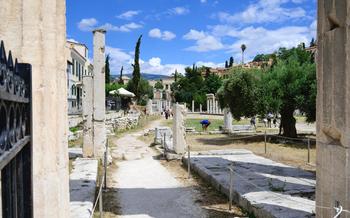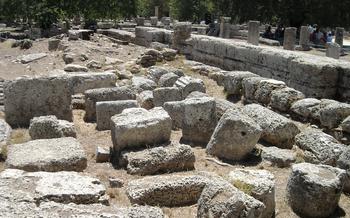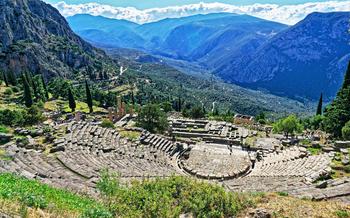
The ancient city of Amphipolis
- The Ancient City of Amphipolis: A Historical and Archaeological Treasure
- The Lion of Amphipolis: A Majestic Symbol of the City
- History and Significance
- Description
- Location and Symbolism
- A Timeless Masterpiece
- Amphipolis Archaeological Museum: A Journey Through History
- The Agora of Amphipolis: A Marketplace and Social Center
- The City Walls of Amphipolis: A Testament to Fortification
- The Tomb of Kasta: An Enigma and a Treasure
- The Roman Amphitheater of Amphipolis: A Venue for Entertainment
- History of the Amphitheater
- Architectural Features
- Archaeological Evidence
- Significance of the Amphitheater
- The Archaeological Site of Amphipolis: A Journey Through Time
- The Acropolis of Amphipolis: A Place of Worship and Power
- The Ancient Theater of Amphipolis: A Stage for Performances
- The Byzantine Church of Amphipolis: A Legacy of the Middle Ages
- The Folklore Museum of Amphipolis: A Celebration of Tradition
- The Natural Beauty of Amphipolis: A Delight for Nature Lovers
- Insider Tip: Amphipolis Food Festival
The Ancient City of Amphipolis: A Historical and Archaeological Treasure
Amphipolis, an ancient city in northern Greece, stands as a testament to the region's rich history and cultural significance. Founded in the 5th century BC by the Athenian general Hagnon, Amphipolis quickly rose to prominence due to its strategic location on the banks of the Strymon River, a vital trade route linking the Aegean Sea to the Balkans. The city's importance was further cemented during the Peloponnesian War, when it became a key battleground between Athens and Sparta, with both sides vying for control of this strategic stronghold. Archaeological discoveries in Amphipolis have unearthed a wealth of treasures, including the majestic Lion of Amphipolis, the imposing city walls, and the Agora, a bustling marketplace and social center. These remnants of the past offer a glimpse into the grandeur and significance of this ancient city, inviting visitors to embark on a journey through time and history.
The Amphipolis Museum, located in the heart of the archaeological site, houses an impressive collection of artifacts excavated from the ancient city. From pottery and sculptures to inscriptions and coins, these artifacts provide valuable insights into the daily lives, beliefs, and artistic achievements of the people who once inhabited Amphipolis. Among the highlights of the museum's collection are the golden wreath from the tomb of Kasta, a testament to the city's wealth and artistry, and the marble statue of Aphrodite, a symbol of beauty and grace. The museum's exhibits are thoughtfully arranged to tell the story of Amphipolis, from its foundation to its decline, offering visitors a comprehensive understanding of this ancient metropolis.
Amphipolis is easily accessible from Thessaloniki, the second-largest city in Greece, with regular bus and train services connecting the two cities. The journey takes approximately two hours, providing travelers with an opportunity to admire the picturesque landscapes of northern Greece along the way. Whether you're a history buff, an archaeology enthusiast, or simply someone who appreciates the beauty of ancient ruins, Amphipolis is a destination that should not be missed.
The Lion of Amphipolis: A Majestic Symbol of the City
History and Significance
The Lion of Amphipolis is an iconic symbol of the ancient city. This impressive sculpture was erected in the 4th century BC to commemorate the victory of the Athenians over the Spartans in the Peloponnesian War. The lion stands tall and proud, symbolizing the strength, power, and courage of the Athenian army.
Description
The Lion of Amphipolis is carved from a single block of marble and stands over 5 meters (16 feet) tall. It depicts a majestic lion with its head held high and its body poised for action. The lion's mane is intricately detailed, and its facial features exude a sense of determination and ferocity.
Location and Symbolism
The Lion of Amphipolis is located at the entrance to the archaeological site of the ancient city. Its prominent position reflects the importance and significance of the sculpture. The lion serves as a reminder of the city's glorious past and its role as a strategic military stronghold.
A Timeless Masterpiece
The Lion of Amphipolis has stood the test of time, enduring the elements and the ravages of history. It remains one of the most recognizable and impressive ancient sculptures in Greece, attracting visitors from all over the world. This majestic lion continues to captivate and inspire, embodying the indomitable spirit of ancient Amphipolis.
Amphipolis Archaeological Museum: A Journey Through History
The Amphipolis Archaeological Museum is a treasure trove of artifacts that provide a glimpse into the rich history and culture of the ancient city. The museum's collection includes pottery, sculptures, inscriptions, and other objects that were discovered during excavations at the archaeological site of Amphipolis.
Among the highlights of the museum are the golden wreath from the tomb of Kasta, the marble statue of Aphrodite, and the mosaic floors from the Roman period. The golden wreath, which is made of pure gold and weighs over 500 grams, is a testament to the wealth and craftsmanship of the ancient Greeks. The marble statue of Aphrodite, which depicts the goddess of love and beauty, is a fine example of classical Greek sculpture. The mosaic floors, which feature intricate designs and colorful tiles, offer a glimpse into the luxurious lifestyle of the Roman elite.
The museum's exhibits are arranged in chronological order, providing visitors with a comprehensive overview of the history of Amphipolis from its foundation in the 5th century BC to its decline in the Byzantine period. The museum also offers guided tours in different languages, which provide visitors with insights into the daily life, culture, and society of ancient Amphipolis.
The Agora of Amphipolis: A Marketplace and Social Center
The Agora, or marketplace, of Amphipolis was a bustling hub of activity in ancient times. It served as a center for trade, commerce, and social interaction, bringing together people from all walks of life. The Agora was a large open square, surrounded by stoas (colonnaded walkways) that provided shelter from the sun and rain. Within the stoas, merchants set up their stalls, selling a variety of goods, including pottery, textiles, jewelry, and agricultural products.
The Agora was not only a place of business but also a place of assembly and religious ceremonies. It was here that the city's citizens gathered to discuss important issues, hold political meetings, and celebrate religious festivals. The Agora also contained a number of public buildings, including the bouleuterion (council house), the prytaneion (government building), and the mint.
Archaeological excavations of the Agora have revealed the foundations of these buildings, as well as the remnants of shops and workshops. Inscriptions recording commercial transactions have also been found, providing valuable insights into the daily life and economy of ancient Amphipolis. The Agora of Amphipolis is a testament to the city's importance as a center of trade, commerce, and social life.
The City Walls of Amphipolis: A Testament to Fortification
The ancient city of Amphipolis was surrounded by a formidable system of defensive walls, a testament to its strategic importance and the need to protect its citizens from attacks and invasions. These walls, constructed during the 5th century BC, were a marvel of engineering and a symbol of the city's strength and resilience.
The walls were built using large blocks of stone, carefully fitted together without the use of mortar. They stood at an impressive height, reaching up to 8 meters in some sections, and were several meters thick, providing a solid barrier against enemy forces. The walls were further strengthened by the incorporation of towers and gates, which allowed for effective defense and surveillance of the surrounding area.
Archaeological excavations have revealed significant portions of the city walls, offering valuable insights into their construction and design. The preserved sections showcase the impressive masonry techniques employed by the ancient builders, with large polygonal blocks forming the foundation and smaller, carefully cut stones used for the upper parts of the walls.
The city walls of Amphipolis played a crucial role in various historical events. During the Peloponnesian War, the city successfully resisted several attacks by the Spartan army, thanks in part to the strength of its fortifications. Later, during the Roman conquest of Greece, the walls provided a final line of defense for the city, which eventually fell to the superior forces of the Roman legions.
Today, the remains of the city walls stand as a testament to the engineering prowess and strategic importance of ancient Amphipolis. They are a reminder of the city's rich history and its significance as a fortified settlement in ancient Greece.
The Tomb of Kasta: An Enigma and a Treasure
In 1977, a farmer stumbled upon an extraordinary discovery in the countryside near Amphipolis: a magnificent circular tomb dating back to the 4th century BC. This enigmatic tomb, known as the Tomb of Kasta, has captivated archaeologists and historians ever since due to its unique architectural features, impressive grave goods, and ongoing debates surrounding its origins and purpose.
The tomb's circular design sets it apart from traditional Macedonian tombs, which are typically rectangular or square. Constructed from large stone blocks, the tomb features an elaborate entrance with two Doric columns and a pediment adorned with intricate carvings. The interior of the tomb is equally impressive, with a vaulted ceiling and a central chamber surrounded by a circular corridor.
Within the tomb, archaeologists discovered a wealth of grave goods, including a stunning gold wreath, intricately crafted jewelry, ceramic vessels, and weapons. The golden wreath, weighing over 1 kilogram, is particularly remarkable for its exquisite workmanship and the depiction of oak leaves and acorns, symbols of power and fertility.
The identity of the person buried in the Tomb of Kasta remains a mystery. Some scholars believe it may have been a member of the Macedonian royal family, while others suggest it could have been a wealthy and powerful individual from the city of Amphipolis. The tomb's elaborate design and rich grave goods certainly support the theory that it was intended for someone of high status.
The purpose of the tomb is also a subject of debate. Some believe it was a cenotaph, a symbolic tomb built in honor of someone who was buried elsewhere. Others suggest it may have been a heroon, a tomb dedicated to a hero or a person of great importance. The ongoing discussions and research surrounding the Tomb of Kasta make it an intriguing and captivating site for visitors interested in ancient history and archaeology.
The Roman Amphitheater of Amphipolis: A Venue for Entertainment
History of the Amphitheater
Constructed during the Roman period, the impressive amphitheater of Amphipolis served as a significant venue for entertainment and public spectacles. Built to accommodate a large audience, it hosted gladiatorial contests, animal fights, and other performances that captivated the ancient city's inhabitants. The amphitheater stands as a testament to the Romans' influence on Amphipolis and the city's vibrant cultural life during that era.
Architectural Features
The amphitheater's design showcased the architectural prowess of the Roman Empire. Its layout featured a central arena surrounded by tiers of seating, allowing spectators to have an unobstructed view of the events taking place below. The seating arrangements were divided into sections based on social status, with the lower tiers reserved for the elite and the upper tiers for the general public. The stage area, located at one end of the arena, provided a platform for gladiators, performers, and other participants in the spectacles.
Archaeological Evidence
Extensive archaeological excavations have revealed the amphitheater's well-preserved remains, providing valuable insights into its construction and use. The seating tiers, stage area, and entrance tunnels have been meticulously unearthed, offering a glimpse into the grandeur of this ancient entertainment complex. Inscriptions and artifacts discovered at the site further shed light on the amphitheater's history and the events that took place within its walls.
Significance of the Amphitheater
The Roman amphitheater of Amphipolis holds significant historical and cultural value. As a prominent entertainment venue, it played a crucial role in the social and cultural life of the ancient city. Its impressive architecture and preserved remains make it a captivating attraction for visitors interested in exploring the rich heritage of Amphipolis and the Roman Empire's influence on the region.
The Archaeological Site of Amphipolis: A Journey Through Time
The archaeological site of Amphipolis is an expansive and captivating testament to the city's rich history and cultural heritage. As you step onto the site, you embark on a journey through time, traversing the remnants of ancient structures and uncovering the stories they hold.
The layout of the site is a testament to the grandeur of Amphipolis. The Agora, the heart of the ancient city, once bustled with activity as people gathered for trade, political discourse, and religious ceremonies. The Acropolis, perched atop a hill, served as the city's religious and administrative center, with temples and government buildings gracing its slopes. Residential areas spread out beyond, offering glimpses into the daily lives of Amphipolis' inhabitants.
Ongoing archaeological excavations have unearthed a wealth of artifacts and structures that provide invaluable insights into the city's past. From intricate mosaics and sculptures to foundations of buildings and remnants of fortifications, each discovery adds to the tapestry of Amphipolis' history.
To fully appreciate the significance of the site, guided tours are available, led by knowledgeable experts who bring the ancient city to life. They delve into the history, architecture, and culture of Amphipolis, shedding light on the lives of its people and the events that shaped their world.
As you wander through the archaeological site, you can't help but be captivated by the palpable sense of history that lingers in the air. Amphipolis' story unfolds before your eyes, inviting you to become a part of its timeless legacy.
The Acropolis of Amphipolis: A Place of Worship and Power
The Acropolis of Amphipolis, a prominent hilltop citadel, stands as a testament to the city's religious and political significance. Commanding breathtaking views of the surrounding landscape, the Acropolis served as a sacred precinct and the seat of power in ancient times. Within its fortified walls, temples and altars were erected to honor deities such as Zeus, the king of the gods, and Athena, the goddess of wisdom and warfare. These sacred structures, adorned with intricate carvings and sculptures, provided a focal point for religious ceremonies and rituals, fostering a deep sense of devotion among the inhabitants of Amphipolis.
Moreover, the Acropolis functioned as the administrative center of the city, housing the government buildings and the residence of the city's rulers. Here, important decisions were made, laws were enacted, and justice was dispensed. The foundations of these administrative buildings, along with inscriptions recording official decrees and transactions, offer valuable insights into the political and civic life of ancient Amphipolis.
As you explore the Acropolis, you can't help but be captivated by the architectural remnants that evoke the grandeur of a bygone era. The preserved fortifications, with their sturdy walls and imposing towers, speak to the strategic importance of the site and its role in defending the city against potential threats. Whether you're a history buff, an architecture enthusiast, or simply someone who appreciates the beauty of ancient ruins, the Acropolis of Amphipolis is a must-visit destination that transports you back in time.
The Ancient Theater of Amphipolis: A Stage for Performances
The ancient theater of Amphipolis, a testament to the city's cultural significance, was constructed during the Hellenistic period, serving as a venue for theatrical productions and other events that entertained and captivated audiences. Its architectural design showcased a traditional layout, with tiered seating arranged in a semicircle around a central stage area. The seating tiers, meticulously crafted from stone, provided comfortable viewing angles for spectators. The stage, with its raised platform and backdrop, offered a dedicated space for performers to showcase their talents.
Archaeological excavations have revealed the well-preserved remains of the theater, allowing visitors to appreciate its grandeur. The seating tiers, though weathered by time, still retain their original form, hinting at the vibrant atmosphere that once filled the space. The stage area, with its intricate carvings and decorative elements, stands as a testament to the artistry and craftsmanship of the ancient builders.
The theater's significance extends beyond its architectural beauty. It served as a vital center for entertainment and cultural expression in ancient Amphipolis. Theatrical performances, ranging from comedies to tragedies, brought the community together, providing a shared experience that transcended social and economic boundaries. The theater also hosted musical concerts, poetry recitals, and other events that enriched the cultural fabric of the city.
Today, the ancient theater of Amphipolis stands as a symbol of the city's rich heritage and its enduring connection to the arts. Visitors can explore the site, imagining the sounds of actors' voices reverberating through the theater and the laughter and applause of the audience filling the air. The theater's legacy continues to inspire and captivate, serving as a reminder of the power of performance and the enduring human desire for artistic expression.
The Byzantine Church of Amphipolis: A Legacy of the Middle Ages
Amidst the ancient ruins of Amphipolis stands a testament to the city's rich history and enduring faith: the Byzantine Church. Constructed during the Byzantine period, this sacred edifice served as a spiritual sanctuary for the Christian community that flourished within the city walls. Its architectural design, adorned with intricate mosaics and well-preserved frescoes, offers a glimpse into the artistic and religious traditions of the Byzantine Empire.
The church's interior is a symphony of colors and symbolism, with vibrant mosaics depicting biblical scenes and revered saints. These intricate artworks, meticulously crafted by skilled artisans, narrate stories of faith, hope, and redemption. The church's well-preserved condition further enhances its significance, providing a tangible link to the religious and cultural heritage of Amphipolis during the Byzantine era.
Beyond its architectural and artistic merits, the Byzantine Church holds immense archaeological importance. Its existence sheds light on the continuity of Christian traditions in the region throughout the centuries. It serves as a reminder of the enduring influence of the Byzantine Empire, whose cultural and religious legacy continues to shape the identity of Amphipolis and the surrounding area.
The Folklore Museum of Amphipolis: A Celebration of Tradition
Nestled in the heart of Amphipolis, the Folklore Museum stands as a testament to the region's rich cultural heritage. Its collection of traditional costumes, tools, household items, and other artifacts offers a glimpse into the way of life, customs, and traditions of the local community.
Exhibitions at the museum showcase the region's agricultural practices, craftsmanship, and festive celebrations. Visitors can learn about the traditional methods of farming, the skills involved in weaving and embroidery, and the vibrant customs associated with weddings, baptisms, and other important events.
Educational programs at the museum play a vital role in promoting cultural awareness and educating visitors about the history and traditions of Amphipolis. Guided tours provide insightful explanations of the exhibits, offering a deeper understanding of the significance of each artifact and its connection to the region's cultural identity.
Through its collections, exhibitions, and educational programs, the Folklore Museum of Amphipolis serves as a bridge between the past and the present, preserving and celebrating the rich cultural traditions that have shaped the identity of this vibrant region.
The Natural Beauty of Amphipolis: A Delight for Nature Lovers
Amphipolis is a treasure trove not only for history and archaeology enthusiasts but also for nature lovers. The city is nestled in a picturesque landscape, offering stunning views of the Strymonas River, the Kerkini Lake, and the surrounding countryside.
The Strymonas River, which flows through Amphipolis, offers a tranquil setting for swimming, fishing, and boating. Visitors can enjoy the refreshing waters of the river and soak in the serene atmosphere of the riverside.
Just a short distance from Amphipolis lies the Kerkini Lake, a natural paradise that is home to a diverse ecosystem. The lake is a haven for birdwatchers, with a variety of bird species, including pelicans, flamingos, and herons, that can be spotted in the area. Visitors can take a boat tour of the lake to observe the birds and other wildlife up close.
The countryside surrounding Amphipolis is equally captivating, with rolling hills, lush forests, and vineyards. The region is perfect for hiking, cycling, and birdwatching, offering visitors a chance to explore the natural beauty of the area and enjoy the fresh air and tranquility of the countryside.
Insider Tip: Amphipolis Food Festival
Every year, Amphipolis comes alive with the flavors and aromas of the Amphipolis Food Festival. This culinary celebration showcases the rich gastronomic traditions of the region, offering visitors a chance to sample a variety of local delicacies and immerse themselves in the vibrant atmosphere of a Greek festival.
During the festival, the streets of Amphipolis are lined with stalls and vendors selling an array of traditional dishes, from grilled meats and fresh seafood to homemade cheeses, pastries, and sweets. Visitors can indulge in the mouthwatering flavors of souvlaki, gyros, moussaka, and other Greek specialties, all prepared with fresh, local ingredients.
In addition to the culinary delights, the Amphipolis Food Festival features live music, dancing, and other cultural performances that showcase the region's rich heritage. The festival provides a wonderful opportunity to interact with locals, experience Greek hospitality, and create lasting memories of a truly unique and unforgettable event.







